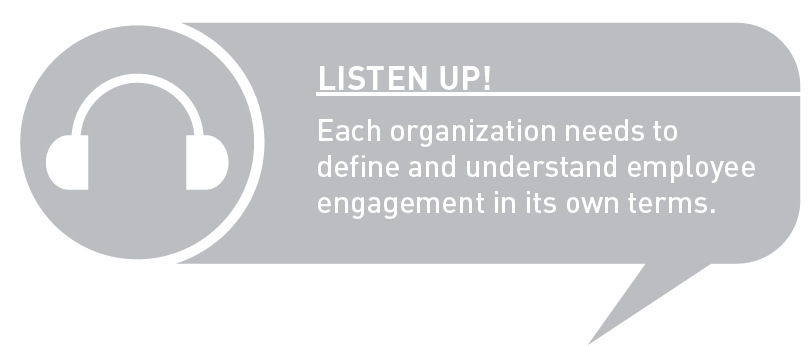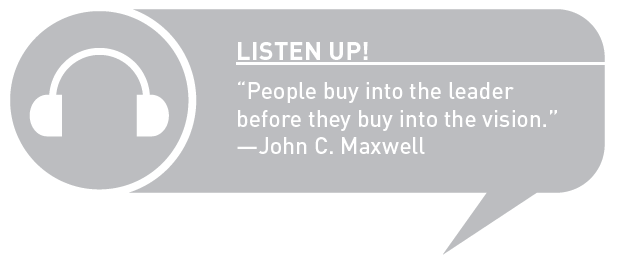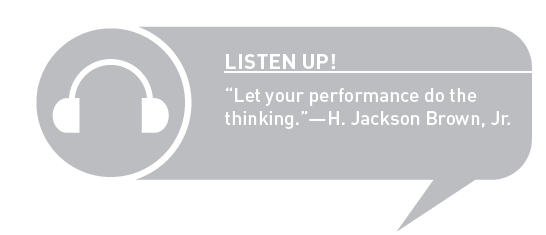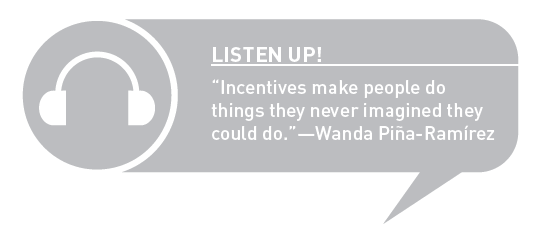Myths and Realities of Employee Engagement
Before we start this journey, let’s see what you think about employee engagement. Review the statements in Worksheet 1.1 and place a check mark or an “x” under the corresponding column if you think the statement is fact or myth. We will review your answers shortly.
Worksheet 1.1Facts and Myths of Employee Engagement
| STATEMENT | FACT | MYTH |
|---|---|---|
| When employees are more engaged, they are more loyal to the company. | ||
| When employees are less engaged, they have more absenteeism. | ||
|
Older employees tend to be more engaged than younger employees. |
||
|
More skilled employees tend to be less engaged than less skilled employees. |
||
|
Men tend to be more engaged than women. |
||
|
Employees who work from home are less engaged than those who do not. |
||
|
Employees who work in shifts are more engaged than those who work regular hours. |
||
|
Recognition fosters engagement. |
||
|
Performance evaluations do not contribute to engagement. |
||
|
Communication promotes engagement. |
||
|
The work environment promotes engagement. |
||
|
Interactions with peers promote engagement. |
||
|
Managers are critical to foster engagement. |
||
|
If an employee has more control over the environment, he is more engaged. |
||
|
Healthy people are less engaged. |
||
|
Promotions always foster employee engagement. |
||
|
Engagement is all about the money. |
||
|
Engagement is not at all about the money. |
||
|
Engagement is all internal. |
||
|
Engagement is all external. |
||
|
Only one definition of engagement exists. |
||
|
The world around employees does not have an impact on their level of engagement. |
||
|
Employee engagement stays the same throughout an employee’s career. |
||
|
Major events or critical incidents do not affect employee engagement. |
||
|
Employees are always engaged with the workplace and their manager. |
Now let’s see how your answers compare with the answers that we expected, as shown in Worksheet 1.2.
Worksheet 1.2 Facts and Myths of Employee Engagement—Expected Answers
| STATEMENT | FACT | MYTH |
|---|---|---|
| When employees are more engaged, they are more loyal to the company. |
X |
|
| When employees are less engaged, they have more absenteeism. |
X |
|
|
Older employees tend to be more engaged than younger employees. |
X |
|
|
More skilled employees tend to be less engaged than less skilled employees. |
X |
|
|
Men tend to be more engaged than women. |
X |
|
|
Employees who work from home are less engaged than those who do not. |
X |
|
|
Employees who work in shifts are more engaged than those who work regular hours. |
X |
|
|
Recognition fosters engagement. |
X |
|
|
Performance evaluations do not contribute to engagement. |
X |
|
|
Communication promotes engagement. |
X |
|
|
The work environment promotes engagement. |
X |
|
|
Interactions with peers promote engagement. |
X |
|
|
Managers are critical to foster engagement. |
X |
|
|
If an employee has more control over the environment, he is more engaged. |
X |
|
|
Healthy people are less engaged. |
X |
|
|
Promotions always foster employee engagement. |
X |
|
|
Engagement is all about the money. |
X |
|
|
Engagement is not at all about the money. |
X |
|
|
Engagement is all internal. |
X |
|
|
Engagement is all external. |
X |
|
|
Only one definition of engagement exists. |
X |
|
|
The world around employees does not have an impact on their level of engagement. |
X |
|
|
Employee engagement stays the same throughout an employee’s career. |
X |
|
|
Major events or critical incidents do not affect employee engagement. |
X |
|
|
Employees are always engaged with the workplace and their manager. |
X |
-
How many did you answer correctly?
-
How many did you answer incorrectly? Which ones?
-
What stands out from your correct and from your incorrect answers?
-
What other facts or myths about employee engagement are common in your company?
We encourage you to review the results of this exercise, as well as your answers to other questions that we will present throughout the book, to continue your journey toward playing a more active role in the development of engagement among your employees.

What Engagement Is for Us and for Them: It’s All About the “I”
We have reviewed some facts and myths about engagement. Before we delve into this topic, we’ll discuss how we define engagement, based on our experience working with clients as well as on our research about this topic. We will continue to ask questions to continue to guide your thinking about engagement.
In our definition: Engagement is the business’s backbone and the result of the psychological contract plus the experience that exists between employee and employer. The foundation of employee engagement is respect, trust, and performance. Engagement is dynamic as it changes over the course of an employee’s tenure at a workplace and overall career as a consequence of multiple events and factors that we will discuss. Engagement is intrinsic and individual. In conclusion, engagement is all about “I.”
Engagement ;is a voluntary connection to the business and to its purpose; it includes an emotional component to the workplace in order to achieve its desired outcomes. Employees decide if they want to be engaged. Thus, even though employee engagement entails an emotional connection, it also involves a rational component as the employee decides whether or not to be engaged given her individual circumstances. We have concluded that, even though many workplaces may seem to be similar, they are as unique as the individuals who belong to them, which in turn affects what it means for employees to be engaged with the organization.
As you may expect, the definitions and explanations of employee engagement are as varied as the authors who have proposed them; however, they have some similarities. These definitions include emotional, rational, and practical features that are connected to engagement’s impact on businesses as well as on employees. In general, these definitions refer to engagement as voluntary. Each well-known definition includes these important components; in addition, there are other factors that contribute to move employee engagement in a particular direction. These factors are typically known as drivers of engagement.

Drivers of Engagement
We have found different types of drivers of engagement. As a manager, you will use some of these drivers to influence your employees’ engagement. We will refer again to these drivers in other chapters where we describe the Engagement “I” Path and the Career “I” Path. Please keep in mind that the impact of these drivers does not happen in isolation; the company’s context and culture will mitigate or compound their impact on employee engagement.
Manager-Employee Relationship
The manager-employee relationship is the most important driver of employee engagement; this relationship has been tied to employees’ satisfaction or dissatisfaction with their work or workplace and their subsequent decision of whether to stay in the workplace or go elsewhere. How you communicate with your employees and what you communicate to them are central issues in the relationship that lies at the heart of the psychological contract we mentioned in our definition of engagement. Therefore, you as a manager have the interesting challenge of forming genuine yet professional relationships with your employees that will benefit the company, the employee, and you.
We have already established that employee engagement has a solid emotional component because engagement is all about “I” (me) and my circumstances. Therefore, employees need to acquire a strong sense of purpose and autonomy in their work even when they may not control the final decision, product, or outcome. This sense of purpose and autonomy is directly tied to their ownership of their work.

Intrinsic Motivation
Intrinsic motivation, defined by Thomas (2009), as “a sense of meaningfulness and of progress” (98), will lead the employee to find value in what he does and to establish that emotional connection without depending on external factors, such as many mentioned in this section. In our work we have found several examples of employees who remain engaged with their workplaces or managers mainly as a result of their strong intrinsic motivation that often takes them through otherwise challenging times.
Leadership
Leadership has different meanings in different companies. Leadership is an important driver of engagement that goes beyond job titles, because not all managers are leaders and not all leaders are managers. A manager like yourself (and others in the company at all levels), has an important responsibility in fostering employee engagement. This responsibility comes through in how you enable your employees to do their work, how you conduct yourself, and how you, as a role model, convey messages through different channels. Our interpretation of a leader is someone who drives people to a common purpose and brings confidence to her team, with the point to make things happen beyond herself. You do not need a title to be a leader.

Performance Management
Performance management is an area related to management that affects employee engagement. For us, performance management includes goals and objectives, as well as how work is distributed to meet company goals. It is an ongoing process that starts when an employee is hired and ends when he leaves the company. As an ongoing process, performance management serves as the company’s platform to align the employee’s actions and behaviors to meet those company goals. Performance management comprises resource allocation, workplace flexibility, and work-life balance, as well as measures of an employee’s progress in achieving the desired results. In addition, how high- and low-performing employees are managed, as well employees’ perceptions of equity and justice, are included in this driver.

Career Development
Career development is another driver of engagement. Even though most employees, especially those who belong to the younger generations, will have several positions at several companies throughout their work lives, those changes are career development. Its meaning may have changed for different groups, but long-term career potential and promotion opportunities are still as relevant today as they were many years ago. These issues are important because they relate to an employee’s intent to stay in the workplace and the resulting decision will have an impact on the business.
An employee who finds opportunities for growth and development within a company will acquire a stronger sense of loyalty to that company and to you as a manager for facilitating those opportunities. This employee will be more likely to intend to stay in the company for a longer period of time and to dedicate that additional time and effort that is often needed to obtain results. Therefore, you as a manager must pay particular attention to the career development needs of your employees and help them to set realistic expectations for their future. At the same time, you should ensure that you match the right employee with the right opportunity at the right time. Don’t be afraid of losing your best employees to other departments or divisions, because if they do not find what they need working with you, they will be more likely to leave your workplace altogether to go somewhere else. Minimize your losses. Keep the big picture of engagement in mind.
Financial and External Incentives
Even though employee engagement extends beyond financial and external incentives, these are still important drivers and need to be considered. Base pay, incentive pay, and total rewards are particularly significant in the current (and recent) economic climate where companies have had to implement tighter controls on costs, including pay and benefits, to survive. Total rewards, defined by World at Work (2011) as “the programs, practices, elements, and dimensions that collectively define an organization’s strategy to attract, motivate, and retain employees” (4), will also play a key role. Employees still focus considerable attention to their compensation and benefits packages when they make a decision to stay in a company or to go elsewhere.

Organizational Image
Shifting our discussion to external components of engagement, we look at organizational image. The view that employees and the outside world have in their minds about an organization and how they feel about an organization becomes the organizational image. In today’s work environment, employees are particularly aware of a company’s image and reputation. The emotional connection that employees feel with their company is composed of how others see it from the outside and how employees see it from the inside. As individuals seek a place to work, they are very much aware of its reputation and how others perceive it because, by joining the company, they are overtly endorsing what it stands for. Let’s look at these examples.
Pablo is very environmentally conscious. He would be attracted to a company known for implementing green programs. Pablo would be very pleased in a paperless environment.
Danielle is very structured and formal; she would be drawn to hierarchical workplaces where roles and responsibilities are clearly defined. Danielle would feel more comfortable in an environment with a strict business dress code.
Steven is focused on creating new ideas that could become profitable products. He would be interested in a company that values results more than processes and procedures and where no one pays particular attention to his choice of attire. Steven would be happy wearing jeans or even shorts, weather permitting, every day.
Each of these individuals, with their varying personalities, would likely choose a different organization to join.
Brand Alignment
Brand alignment is another driver related to organizational image. With today’s availability of information through multiple channels, often accessed simultaneously, it is very easy for an employee to find out if the company is acting consistently with its brand, or what makes it unique among its competitors. For example, a company that prides itself on its community orientation and service would be initially appealing to an employee who likes to spend time working for the common good. Any contradiction between what the company says it would do and what it actually does would have a negative impact on that employee’s engagement. In this example, if the company’s real connection with the community is limited to only collecting funds for nonprofit groups, the service-oriented employee will feel disappointed and will, very likely, begin to feel disengaged after joining the company. Brand alignment ensures that people know and understand an organization’s brand and purpose and that they demonstrate that they “live the brand” in everything that they do, everywhere that they do it, and every time that they do it.

In this section, we discussed different drivers that contribute to overall employee engagement. Although many believe that an employee’s relationship with a company is essentially an exchange of services for goods, our experience has shown other dimensions of the workplace, such as manager-employee relationship and the “I” factor, contribute to employee engagement. We would now like you to reflect on what we just discussed.
Now it’s your turn.
Let’s look at your definitions of employee engagement.
-
What is your definition of employee engagement?
-
How is your definition of employee engagement similar or different from your company’s definition?
-
Think about our definition of engagement and write your new definition of engagement.
Your answers to these questions will help you understand where you are as you promote engagement among your employees. This is your first step in this journey.
Let’s test your “I.”
-
Am I engaged?
-
How engaged am I?
-
What does “being engaged” mean to me?
-
Do I care about engagement?
-
Am I engaged to my manager or to my workplace? Am I engaged to both or to none? Why?
-
What are my expectations about engagement?
-
What do I need to be engaged? (Describe in as much detail as possible.)
-
What drives my engagement?
Now let’s test your Company “I.”
-
What drives engagement in your company?
-
What drives engagement for your employees?
-
Does your company care about employee engagement?
-
What initiatives in employee engagement is your company taking?
-
Is your company measuring employee engagement?
-
What steps is your company taking with those employee engagement measures?
-
As a manager, are you accountable for employee engagement?
-
Who is responsible to drive employee engagement in your company?
In the next section, we share with you a review of general trends in employee engagement that may be useful to you as you place employee engagement in your company in a broader context.
Trends in Employee Engagement: Some Statistics
Books about engagement typically include large amounts of statistics and data, but we said at the beginning that this book would not do so. However, we would like to place trends in employee engagement in a broader context. Please keep in mind that measures and methods may appraise engagement differently because they are based on individual operational definitions of engagement. Here are some statistics for you to keep in mind.
According to Aon Hewitt (2011), globally, 60 percent of employees were engaged in 2009, but 56 percent of employees were engaged in 2010. The authors consider this change as the largest decline in engagement in 15 years and attribute it to shifts in specific industries, such as financial, and in specific regions, such as Asia-Pacific, Europe, and North America regions.
According to Towers Watson (2012), globally, 35 percent of employees are highly engaged (that is they have high scores on traditional engagement, energy, and enablement); 22 percent of employees are unsupported (are traditionally engaged, but lack either enablement or energy); 17 percent of employees are detached (have either enablement or energy, but do not have traditional engagement); and 26 percent of employees are disengaged (have low scores on the three attributes). Similarly, Harter (2012) reports that 30 percent of United States workers are engaged in their work and workplace, 52 percent are not engaged, and 18 percent are actively disengaged. Based on the reports of these authors, the majority of workers are not engaged in their jobs.
We have found differences in employee engagement depending on education, age, and gender among employees with comparable income levels. Specifically, those employees who have high school or higher degrees are less likely to be engaged than those with less than a high school degree or some college education. Employees who have higher education tend to have more options for mobility and, consequently, they tend to have less engagement. Therefore, companies need to dedicate more efforts to retain these employees. Employees who are between the ages of 30 to 50 are less likely to be engaged than older employees; those employees who are between the ages of 50 to 60 are seeking stability in their lives and those who are over age 60 are embracing stability. In the economic climate of the 2010s, we are seeing more employees who are over the age of 70 staying active in the workforce, reinventing themselves, and evolving dramatically. Further, because of changes in family structures that have led many women to become the primary wage earners of their families, women tend to be more engaged than men and tend to stay with the same organization longer.
Job-related factors, such as job role and length of time at position, are indicators of employee engagement. In our experience, professional employees tend to be more engaged than nonprofessional employees regardless of educational attainment. By professional employees we mean those who look at their employment as a career instead of as a job and who have made considerable investments, often in terms of time, money, and effort, to build their present and future. Typically, professional employees are salaried employees who tend to look for career paths and other growth opportunities within companies and who are not satisfied with remaining in one position throughout their entire working lives. From our point of view, more than half of employees are disengaged by the time they reach three years at their jobs; at this time they often begin to look for what to do next, either in their current company or elsewhere. This question of “What should I do next?” arises every three to five years of service.
Before we shift our attention to our next topic, we would like you to reflect on what we have shared with you in this section.
Now it’s your turn.
Let’s look at measures and trends in employee engagement to help you to calibrate employee engagement in your company.
-
How do you measure employee engagement in your team?
-
What is your team’s level of employee engagement?
-
How does your company’s level of employee engagement compare with that of your competitors?
-
Has your company’s level of employee engagement changed over the last three to five years, or has it remained consistent?
-
To what do you attribute any changes in engagement over the last three to five years?
-
Are there any differences in employee engagement between groups such as professionals and nonprofessional workers?
-
Are there any differences in employee engagement between supervisors, senior managers, and individual contributors?
-
Are there any differences in employee engagement between groups such as those who have a high school education or higher and those who have less than a high school education?
-
Are there any differences in employee engagement between genders?
-
To what do you attribute any differences in employee engagement between groups?
Impact of Employee Engagement
The ways to measure and analyze the impact of employee engagement on businesses, as well as on employees, are as varied and diverse as the studies conducted to identify this impact. Metrics depend on each industry, but all industries have financial indicators. Customer satisfaction and employee turnover are usually good indicators of business impact. Engagement may be an important predictor of a company’s health, and often organizations that report higher levels of employee engagement continue to outperform those that report lower levels of engagement. In this section, we highlight the impact of employee engagement on businesses and then on employees.
On Businesses
According to Hewitt Associates (2010), those companies with higher levels of engagement have a base from which to build engagement further, and those that do not continue to lose ground in engagement. Aon Hewitt (2012) presented that the best employers average 20 percent higher engagement than other employers; and companies in the top quartile of the best employers in 2012 had 50 percent higher total shareholder return than the average company. So overall, addressing the issue of employee engagement makes business sense.
On Employees
Engagement seems to serve as a filter when employees are handling difficult work situations such as crises, layoffs, and mergers. For example, we have seen highly engaged employees come together during times of an organizational crisis because of their sense of ownership and belonging; less engaged employees may resist working additional hours or may resent taking pay cuts for the benefit of the greater good. We have also found that highly engaged employees may perceive layoffs, particularly those as a result of a merger, differently than less engaged employees. Highly engaged employees may feel a greater sense of loss than less engaged employees because they were more emotionally invested in the company and they believe that the company owes something to them as part of that psychological contract that we have mentioned previously in this chapter.
Engagement also seems to contribute to overall employee well-being since more engaged employees tend to experience higher levels of well-being than those who are not engaged. In our experience, how employees handle work-related stress tends to be related to their levels of engagement, as more engaged employees tend to handle stress better than less engaged employees.
Now it’s your turn.
Let’s look at the impact of employee engagement on your company.
-
What has been the impact of employee engagement on your company?
-
What has been the impact of employee engagement on the employees of your company?
-
Are there any differences in the impact of employee engagement on your company based on any particular situations?
KEY POINTS AND TAKEAWAYS
-
Engagement is the backbone of the business.
-
Take into consideration the employee’s psychological contract with the company.
-
Engagement is all about the “I” (me) and my circumstances.
-
Consider the manager-employee relationship.
-
Engagement has a solid emotional component.
-
Keep in mind factors such as education, gender, and roles, among others.
-
Engaged companies outperform those that report lower levels of engagement.
